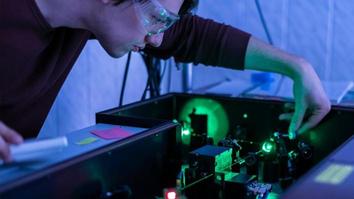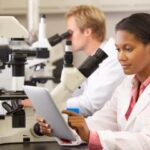What Physicists and Astronomers Do
Physicists and astronomers study the ways in which various forms of matter and energy interact. Theoretical physicists and astronomers may study the nature of time or the origin of the universe. Some physicists design and perform experiments with sophisticated equipment such as particle accelerators, electron microscopes, and lasers.
Duties of Physicists and Astronomers
Physicists and astronomers typically do the following:
· Develop scientific theories and models that attempt to explain the properties of the natural world, such as the force of gravity or the formation of sub-atomic particles
· Plan and conduct scientific experiments and studies to test theories and discover properties of matter and energy
· Write proposals and apply for funding to conduct research
· Do complex mathematical calculations to analyze physical and astronomical data, such as data that may indicate the existence of planets in distant solar systems or new properties of materials
· Design new scientific equipment, such as telescopes and lasers
· Develop computer software to analyze and model data
· Write scientific papers that may be published in scholarly journals
· Present research findings at scientific conferences and lectures
Physicists explore the fundamental properties and laws that govern space, time, energy, and matter. Some physicists study theoretical areas, such as the fundamental properties of atoms and molecules and the evolution of the universe. Others design and perform experiments with sophisticated equipment such as particle accelerators, electron microscopes, and lasers. Many apply their knowledge of physics to practical objectives, such as developing advanced materials and medical equipment.
Astronomers study planets, stars, galaxies, and other celestial bodies. They use ground-based equipment, such as radio and optical telescopes, and space-based equipment, such as the Hubble Space Telescope or the coming James Webb Space Telescope. Some astronomers study distant stars, galaxies, and phenomena such as neutron stars and black holes, and others monitor space debris that could interfere with satellite operations.
Many physicists and astronomers work in basic research with the aim of increasing scientific knowledge. These researchers may attempt to develop theories that better explain what gravity is or how the universe works or was formed. Other physicists and astronomers work in applied research. They use the knowledge gained from basic research to effect new developments in areas such as energy storage, electronics, communications, navigation, and medical technology.
Astronomers and physicists typically work on research teams together with engineers, technicians, and other scientists. Some senior astronomers and physicists may be responsible for assigning tasks to other team members and monitoring their progress. They may also be responsible for finding funding for their projects and therefore may need to write applications for research funding.
Experimental physicists develop new equipment or sensors to study properties of matter, create theories, and test them through experiments. Theoretical and computational physicists develop new theories that can predict properties of materials, or describe unexplained experimental results. Although all of physics involves the same fundamental principles, physicists generally specialize in one of many subfields. The following are examples of types of physicists:
Astrophysicists study the physics of the universe. “Astrophysics” is a term that is often used interchangeably with “astronomy.”
Atomic, molecular, and optical physicists study atoms, simple molecules, electrons, and light, as well as the interactions among them. Some look for ways to control the states of individual atoms, because such control might allow for further miniaturization or might contribute toward the development of new materials or computer technology.
Condensed matter and materials physicists study the physical properties of matter in molecules, nanostructures, or novel compounds. They study a wide range of phenomena, such as superconductivity, liquid crystals, sensors, and nanomachines.
Medical physicists work in healthcare and use their knowledge of physics to develop new medical technologies and radiation-based treatments. For example, some develop better and safer radiation therapies for cancer patients. Others may develop more accurate imaging technologies that use various forms of radiant energy, such as magnetic resonance imaging (MRI) and ultrasound imaging.
Particle and nuclear physicists study the properties of atomic and subatomic particles, such as quarks, electrons, and nuclei, and the forces that cause their interactions.
Plasma physicists study plasmas, which are considered a distinct state of matter and occur naturally in stars and interplanetary space and artificially in neon signs and plasma screen televisions. Many plasma physicists study ways to create fusion reactors that might be a future source of energy.
Unlike physicists, astronomers cannot experiment on their subjects, because they are so far away that they cannot be touched or interacted with. Therefore, astronomers generally make observations or work on theory. Observational astronomers observe celestial objects and collect data on them. Theoretical astronomers analyze, model, and theorize about systems and how they work and evolve. The following are examples of types of astronomers who specialize by the objects and phenomena they study:
Cosmologists and extragalactic astronomers study the entire universe. They study the creation, evolution, and possible futures of the universe and its galaxies. These scientists have recently developed several theories important to the study of physics and astronomy, including string, dark-matter, and dark-energy theories.
Galactic, planetary, solar, and stellar astronomers study phenomena that take place in the universe at the scale of stars, planets, and solar systems. For example, these astronomers study the sun, stellar evolution, planetary formation, and interactions between stars
Optical and radio astronomers use optical or radio telescopes to study motions and evolution of stars, galaxies, and the larger scale structure of the universe.
Growing numbers of physicists work in interdisciplinary fields, such as biophysics, chemical physics, and geophysics. For more information, see the profiles onbiochemists and biophysicists and geoscientists.
Many people with a physics or astronomy background become professors or teachers. For more information, see the profiles on high school teachers and postsecondary teachers.
Work Environment for Physicists and Astronomers
Astronomers hold about 2,000 jobs. The largest employers of astronomers are as follows:
| Colleges, universities, and professional schools; state, local, and private | 40% |
| Federal government, excluding postal service | 23 |
Physicists hold about 17,900 jobs. The largest employers of physicists are as follows:
| Scientific research and development services | 30% |
| Colleges, universities, and professional schools; state, local, and private | 22 |
| Federal government, excluding postal service | 19 |
| Hospitals; state, local, and private | 8 |
| Ambulatory healthcare services | 4 |
The National Aeronautics and Space Administration (NASA) and agencies within the U.S. Department of Defense have traditionally been two of the largest employers of physicists and astronomers in the federal government. The scientific research-and-development industry includes both private and federally funded national laboratories, such as the Lawrence Livermore Laboratory in California, the Los Alamos National Laboratory in New Mexico, and the Goddard Institute in Maryland.
Physics research is usually done in small- or medium-sized laboratories. However, experiments in some areas of physics, such as nuclear and high-energy physics, may require extremely large and expensive equipment, such as particle accelerators and nuclear reactors. Although physics research may require extensive experimentation in laboratories, physicists still spend much of their time in offices, planning, analyzing, fundraising, and reporting on research.
Most astronomers work in offices and may visit observatories a few times a year. An observatory is a building that houses ground-based telescopes used to gather data and make observations. Some astronomers work full time in observatories.
Some physicists and astronomers work away from home temporarily at national or international facilities that have unique equipment, such as particle accelerators and gamma ray telescopes. They also frequently travel to meetings to present research results, discuss ideas with colleagues, and learn more about new developments in their field.
Physicist and Astronomer Work Schedules
Most physicists and astronomers work full time. Astronomers may need to work at night, because radiation from the sun tends to interfere less with observations made during nighttime hours. Astronomers typically visit observatories only a few times per year and therefore keep normal office hours.
How to Become a Physicist or Astronomer
Physicists and astronomers typically need a Ph.D. for jobs in research and academia. However, physicist jobs in the federal government typically require a bachelor’s degree in physics. After receiving a Ph.D. in physics or astronomy, many researchers seeking careers in academia begin in temporary postdoctoral research positions.
Education for Physicists and Astronomers
A Ph.D. in physics, astronomy, or a related field is needed for jobs in research or academia or for independent research positions in industry.
Graduate students usually concentrate in a subfield of physics or astronomy, such as condensed matter physics or cosmology. In addition to taking courses in physics or astronomy, Ph.D. students need to take courses in math, such as calculus, linear algebra, and statistics. Computer science classes also are essential, because physicists and astronomers often develop specialized computer programs that are used to gather, analyze, and model data.
Those with a master’s degree in physics may qualify for jobs in applied research and development for manufacturing and healthcare companies. Many master’s degree programs specialize in preparing students for physics-related research-and-development positions that do not require a Ph.D.
Most physics and astronomy graduate students have a bachelor’s degree in physics or a related field. A bachelor’s degree in physics is often considered good preparation for Ph.D. programs in astronomy, although an undergraduate degree in astronomy may be preferred by some universities. Undergraduate physics programs provide a broad background in the natural sciences and mathematics. Typical courses include classical and quantum mechanics, thermodynamics, optics, and electromagnetism.
Students may choose to complete an internship during their undergraduate curriculum in order to gain additional hands-on experience. The American Astronomical Society has a directory of internships for astronomy students, and the American Physical Society lists internships for students in physics.
Jobseekers with only a bachelor’s degree in physics usually are qualified to work as technicians and research assistants in related fields, such as engineering and computer science. Those with a bachelor’s degree in astronomy also may qualify to work as an assistant at an observatory. Students who do not want to continue their studies to the doctoral level may want to take courses in instrument building and computer science.
Some master’s degree and bachelor’s degree holders find work in the federal government. Others may become science teachers in middle schools and high schools.
Physicist and Astronomer Training
Many physics and astronomy Ph.D. holders who seek employment as full-time researchers begin their careers in a temporary postdoctoral research position, which typically lasts 2 to 3 years. During their postdoctoral appointment, they work with experienced scientists and continue to learn about their specialties or develop a broader understanding of related areas of research. Senior scientists may carefully supervise their initial work, but as these postdoctoral workers gain experience, they usually do more complex tasks and have greater independence in their work.
Important Qualities for Physicists and Astronomers
Analytical skills. Physicists and astronomers need to think logically in order to carry out scientific experiments and studies. They must be precise and accurate in their analyses because errors could invalidate their research.
Communication skills. Physicists and astronomers present their research at scientific conferences, to the public, or to government and business leaders. Physicists and astronomers write technical reports that may be published in scientific journals. They also write proposals for research funding.
Critical-thinking skills. Physicists and astronomers must carefully evaluate their own work and the work of others. They must determine whether results and conclusions are accurate and based on sound science.
Curiosity. Physicists and astronomers work in fields that are on the cutting edge of technology. They must be very keen to learn continuously throughout their careers in order to keep up with advances in a wide range of technical subjects.
Interpersonal skills. Physicists and astronomers must collaborate extensively with others in both academic and industrial research contexts. They need to work well with others toward a common goal. Interpersonal skills also should help researchers secure funding for their projects.
Math skills. Physicists and astronomers perform complex calculations involving calculus, geometry, algebra, and other areas of math. They must express their research in mathematical terms.
Problem-solving skills. Physicists and astronomers use scientific observation and analysis, as well as creative thinking, to solve complex scientific problems. Physicists and astronomers may need to redesign their approach and find a solution when an experiment or theory fails to produce the needed information or result.
Self-discipline. Physicists and astronomers need to stay motivated, since they spend a lot of time analyzing large datasets to try to discern patterns that will yield information. This work requires the ability to focus for long periods.
Licenses, Certifications, and Registrations for Physicists and Astronomers
Some positions with the federal government, such as those involving nuclear energy and other sensitive research areas, may require applicants to be U.S. citizens and hold a security clearance.
Advancement for Physicists and Astronomers
With experience, physicists and astronomers may gain greater independence in their work, as well as larger research budgets. Those in university positions may also gain tenure with more experience. Some physicists and astronomers move into managerial positions, typically as a natural sciences manager, and spend a large part of their time preparing budgets and schedules. Physicists and astronomers need a Ph.D. for most management positions.


